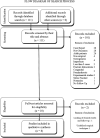Treatment of olecranon fractures in childhood: A systematic review
- PMID: 36467486
- PMCID: PMC9715971
- DOI: 10.3389/fped.2022.1046243
Treatment of olecranon fractures in childhood: A systematic review
Abstract
Background: Literature over the last 20 years provides evidence for a surgical treatment of displaced olecranon fractures in children, this is usually obtained with commonly proposed methods, although there is no general agreement about the best recommended technique.
Aim: Identifying the best surgical technique in displaced olecranon fractures in children and the role of associated fractures in the prognosis of these lesions, by analyzing the most relevant studies on this topic.
Methods: A literature search was performed in MEDLINE database and Scopus database. Articles reporting clinical outcomes of pediatric patients affected by olecranon fractures treated surgically were identified.
Results: The initial search produced 111 studies, with 8 fulfilling the eligibility criteria of our study. Selected articles (2002-2022) included 122 patients overall.
Conclusion: Displaced olecranon fractures, occurring during skeletal growth and surgically treated, generally have good results, although we are unable to recommend the best surgical treatment based on our review. In most cases, they are intra-articular fractures; thus, the overall goal is to get an anatomic reduction that in some cases cannot be obtained by percutaneous techniques. Tension band suture is the preferred device, although it is not recommended in adolescence for the high risk of fixation failure. Associated lesions may affect results.
Keywords: children; fracture; olecranon; pediatric; surgery; surgical procedures; surgical treament; upper limb.
© 2022 De Maio, Gorgolini, Caterini, Luciano, Covino and Farsetti.
Conflict of interest statement
The authors declare that the research was conducted in the absence of any commercial or financial relationships that could be construed as a potential conflict of interest.
References
-
- Andreacchio A, Canavese F, Villa R. The child elbow. Practical approach to traumatic and orthopedic disorders. Como, Italy: Timeo; (2020).
Publication types
LinkOut - more resources
Full Text Sources


